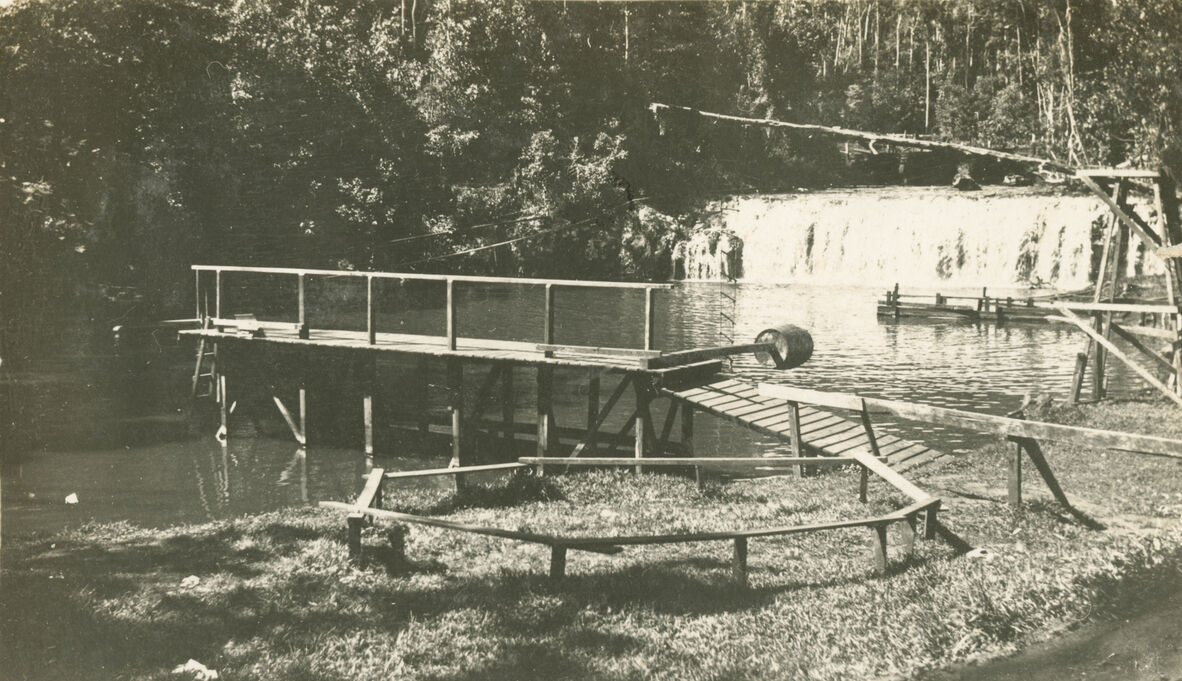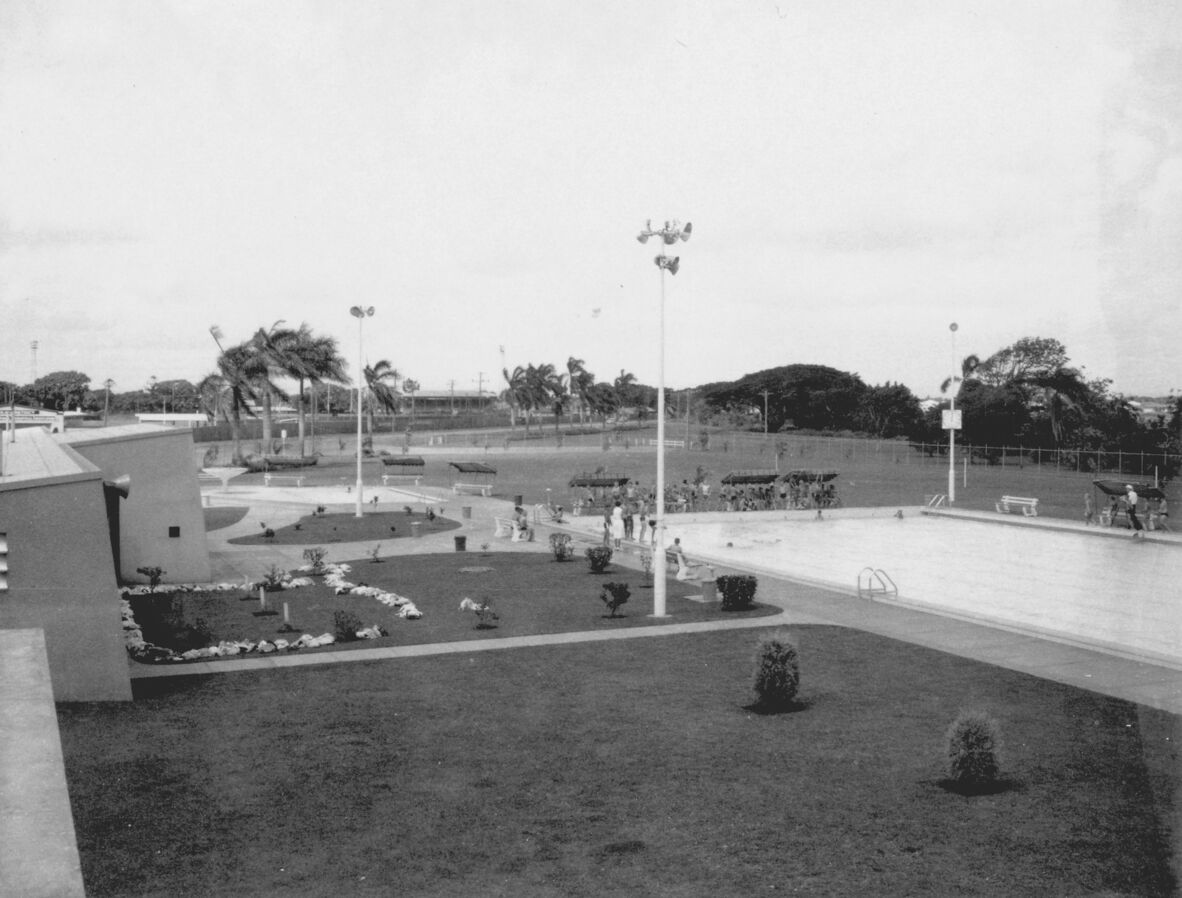Connecting sporting memory and record with state heritage
By Dr Kate Kirby, 2025 Queensland Heritage Register Fellow | 19 June 2025
Guest blogger: Dr Kate Kirby, 2025 Queensland Heritage Register Fellow.
What is your most significant sporting memory? The local pool where you swam your first lap? The school sports oval where you raced your first 100-metre run, and a PE teacher pinned a green third-place ribbon to your shirt? Or perhaps it was at the local court where you picked up a WD Bib and played your first quarter of netball?
Our memories of sporting significance are sometimes held alone, and at other times, they are shared with family, team members, or within local communities. The memory may exist in a shared story or be imbued in tangible sporting mementoes such as old trophies, uniforms, or photographs. Discovering such items in the back of cupboards or sheds can bring back a flood of memories, and possibly emotions, of past sporting experiences.
There is a connection between community sporting memories and sporting significance to the state of Queensland. Sport heritage is linked to Queenslander identity. Across cities, regional towns, and rural areas of Queensland, markers of this heritage exist. Sometimes noted with a careful sign, and at other times faded, only reprised through the local sharing of sporting memory.
At the state level, the Queensland Heritage Register plays a crucial role in documenting places of cultural heritage significance to the people of Queensland. It is not just a list of architectural feats, but also includes places of sport heritage significance, as suggested by the Queensland community.
Entries in the register most frequently demonstrate a connection to sport through:
- Historical significance: demonstrating the evolution or pattern of Queensland’s sport history (criteria A), or through links with a prominent sportsperson, club or association (criteria H).
- Rarity: demonstrating rare, uncommon or endangered aspects of Queensland’s cultural and sporting heritage (criteria B).
- Social significance: with a strong or special link with a particular sporting community or cultural group for social, cultural or spiritual reasons (criteria G).
Some places of sporting significance are already included in the register, such as racecourses, swimming pools, and parks.
The Gayndah Racecourse in the North Burnett region of Queensland was added to the Queensland Heritage Register in 2005. Established in the 1850s, it was the venue for the first Queensland Derby race in 1868. The register entry relates to its demonstration of the evolution and pattern of Queensland’s racing history, and it is one of three racecourse places currently registered.
Entry in the Gayndah Queensland Jockey Club original race ledger, 1861. R 123, Gayndah Jockey Club Records, John Oxley Library, State Library of Queensland.
Souvenir Programme of the Centenary Derby Meeting at the Gayndah Racecourse, 1968.. R 123, Gayndah Jockey Club Records, John Oxley Library, State Library of Queensland.
The Malanda Falls Swimming Pool is in the Johnstone River and was added to the Queensland Heritage Register in 2010. As a natural swimming location, the pool has a significant recreation and tourism history.

Diving platform over the swimming pool at the Malanda Falls, Queensland, (n.d.). 30719 Reverend Herbert Norton Papers, John Oxley Library, State Library of Queensland, Image number: 30719-0001-0209.
Queen’s Park, Ipswich, was added to the Queensland Heritage Register in 2002, with its significance linked to the history of croquet, lawn bowls, and lawn tennis in Queensland. The Ipswich Croquet Club was based at the park in the early 1900s, with a clubhouse added in the 1930s.
Ipswich croquet courts, 1904. Photographs of croquet, Copy Print Collection, State Library of Queensland.
The Mackay Memorial Swimming Pool was added to the Queensland Heritage Register in 2020 as an intact example of post-war memorial pool construction. The history of local communities lobbying for the development of regional swimming facilities is also recognised in the entry.

Mackay Memorial Swimming Pool, Mackay, ca. 1963. Mackay Regional Council, 2009. Image number: qmc04811.
Research for the 2025 Queensland Heritage Register Fellowship aims to expand how sport and recreation patterns in Queensland's history are acknowledged via the Queensland Heritage Register. State Library's John Oxley Library collection will offer some connections. Tangible sport heritage in regional areas of Queensland exists, but is not always visible in broader state systems of recognition. Therefore, the memories and records in regional and rural archives are also a key element of this project. As I travel through regional Queensland, I hope to further connect sporting memories and records of Queenslanders with broader approaches to recognising heritage significance. Memories and records from your local sporting clubs, events and achievements may be an essential part of this story.
Dr Kate Kirby
The Queensland Heritage Register Fellowship is generously supported by the Heritage Branch, Department of Environment, Science and Innovation.
Other blogs by Dr Kate Kirby:
Kate's planned itinerary to explore and research Queensland's Sporting Heritage.
| Month | Local Government Area | Qld Heritage Register Places |
|---|---|---|
| June | 26-27 June, Ipswich. (Ipswich City Council). |
|
| July | 31 July, Gympie. (Gympie Regional Council). |
|
| July | 22-24 July, Gold Coast. (Gold Coast City Council). |
|
| July | 31 July, Noosa. (Noosa Shire Council). |
|
| August | 1 August, Caloundra. (Sunshine Coast Regional Council). |
|
| August | 19 August, Toogoolawah.(Somerset Regional Council). |
|
| September | 4 September, Warwick.(Southern Downs Regional Council). |
|
| September | 22 September, Deception Bay. (Moreton Bay Regional Council). |
|
| September | 29-30 September, Townsville. (Townville City Council). |
|
| October | 1-2 October, Charters Towers. (Charters Towers Regional Council). |
|
| November | 3-5 November, Mount Isa.(Mount Isa City Council). | |
| November | 24 November, Emu Park.(Livingstone Shire Council). |
|
| November | 25 November, Rockhampton.(Rockhampton Regional Council). |
|
| November | 26 November, Gladstone (Gladstone Regional Council). |
|
| December | 8 December, Charleville.(Murweh Shire Council). |
|
| December | 9 December, Roma.(Maranoa Regional Council). |
|
| December | 10 December, Dalby.(Western Downs Regional Council). |
|
| December | 11-12 December, Toowoomba.(Toowoomba Regional Council). |
|
| December | 29 December, Gayndah.(North Burnett Regional Council). |
|
Watch this video to explore Kate's research project, and don’t miss the full video highlighting all the 2025 Queensland Memory Awards recipients and their inspiring projects.
Comments
Your email address will not be published.
We welcome relevant, respectful comments.